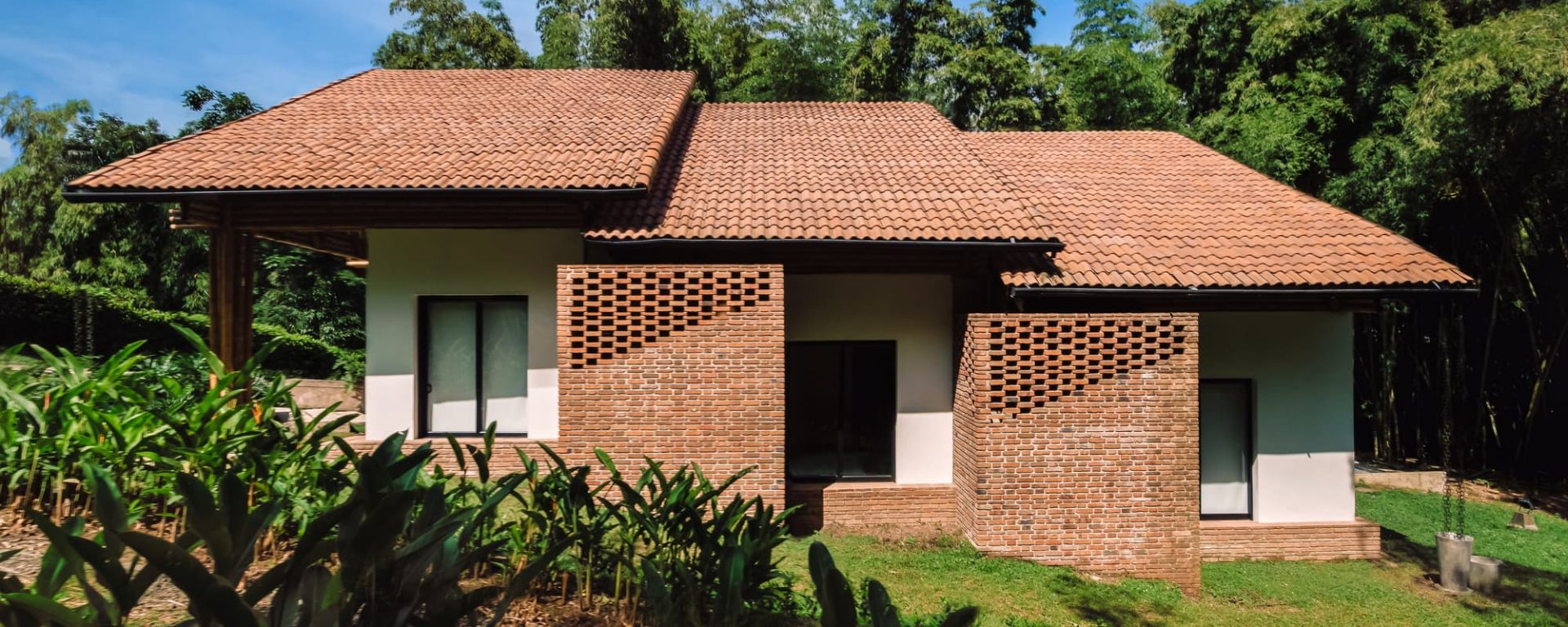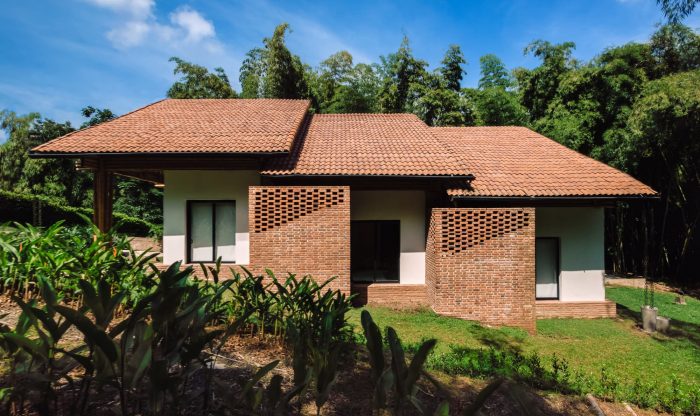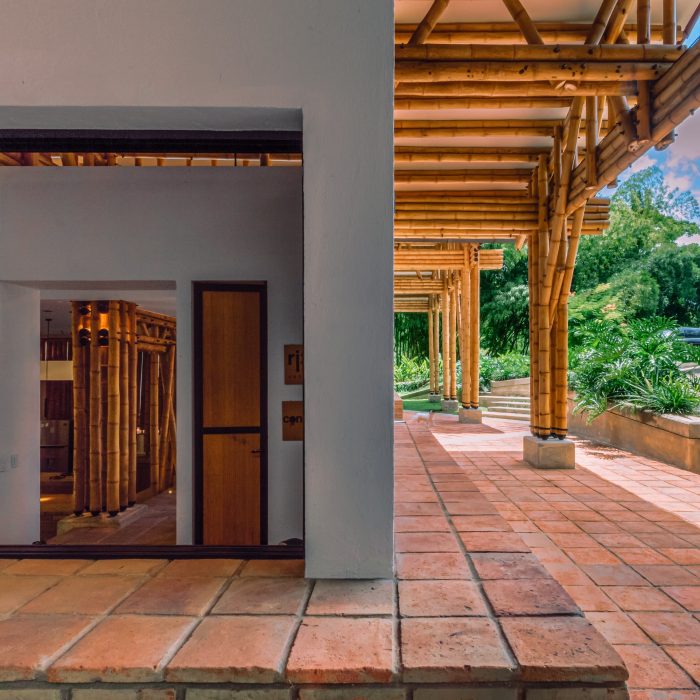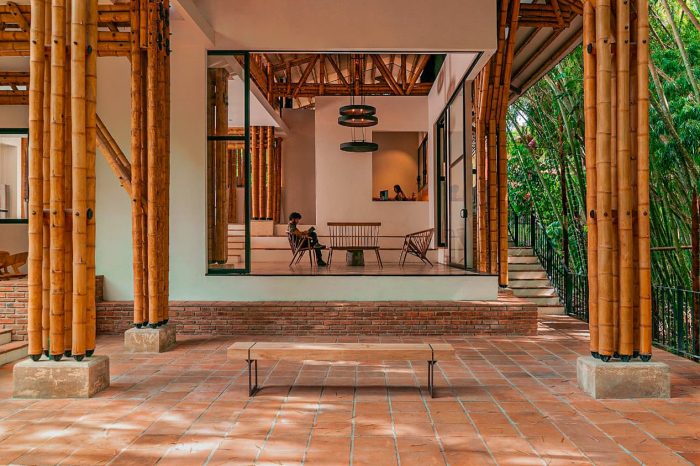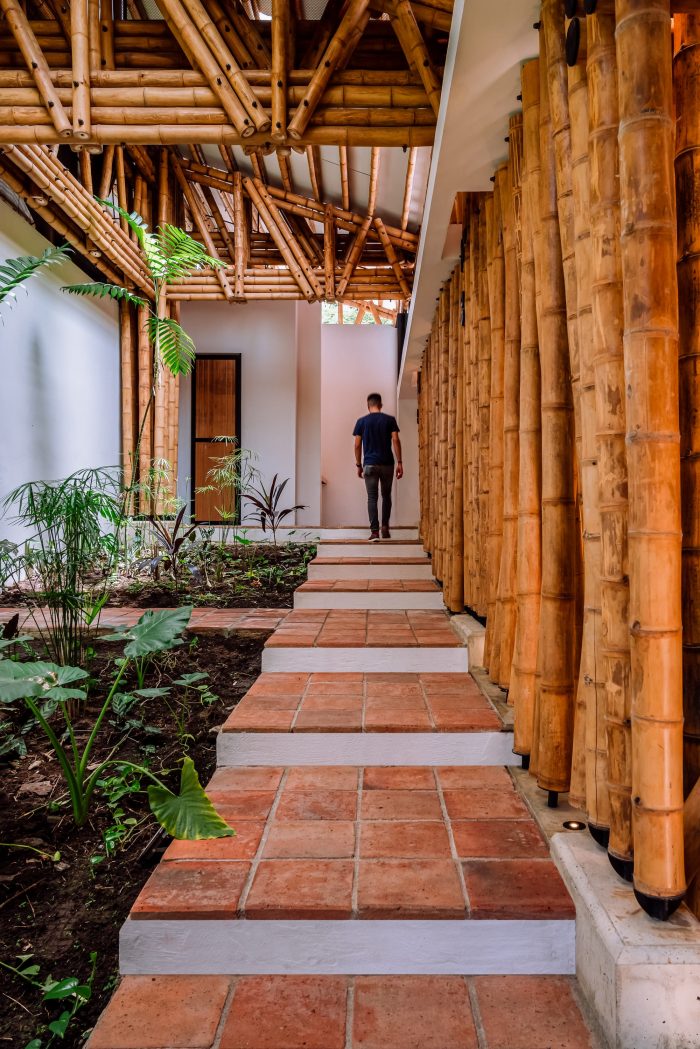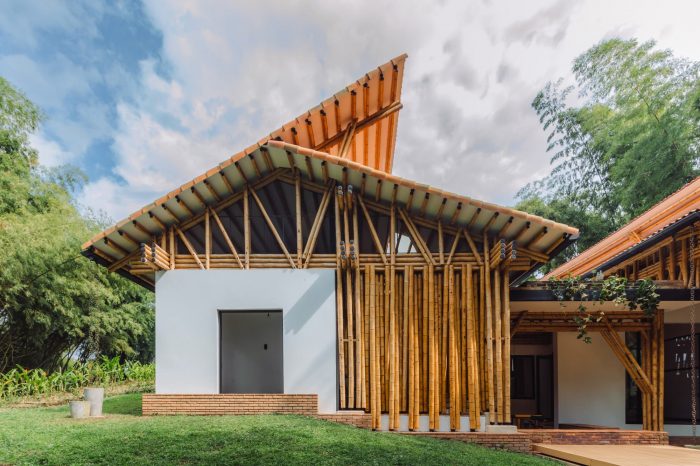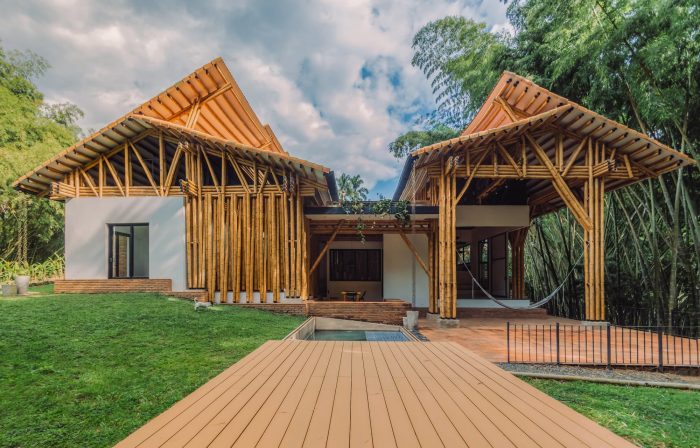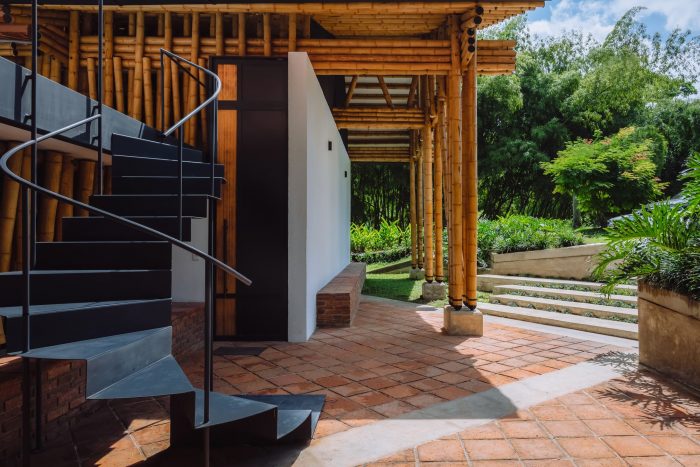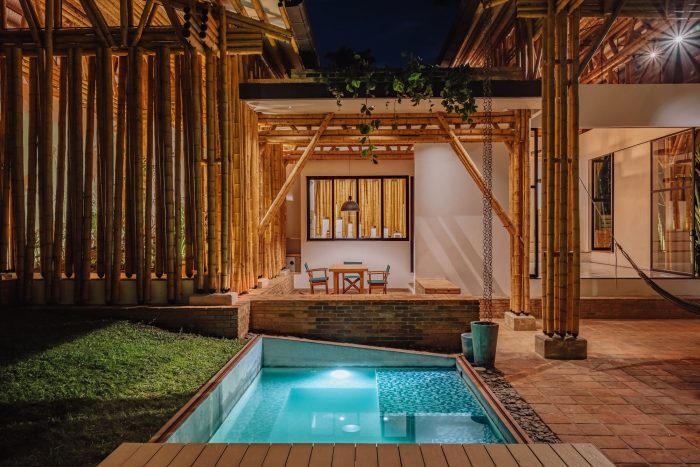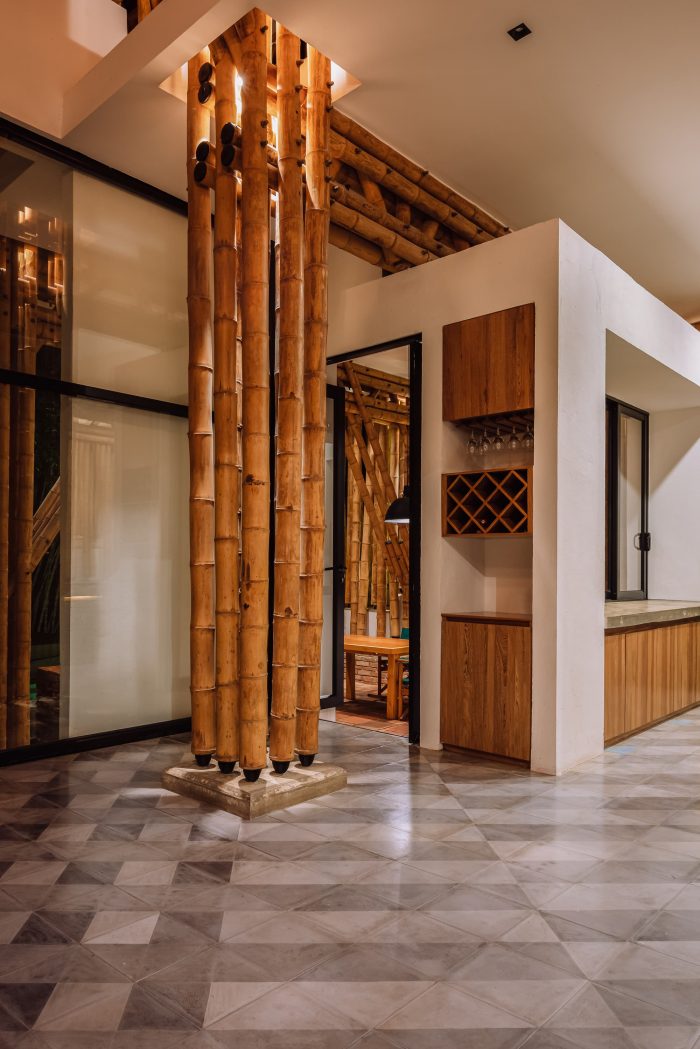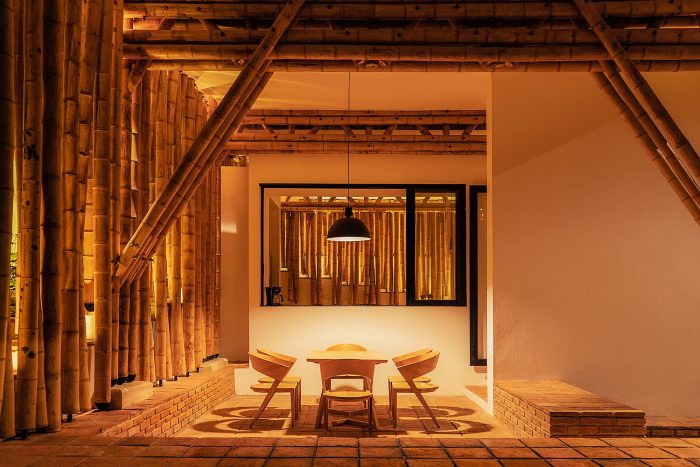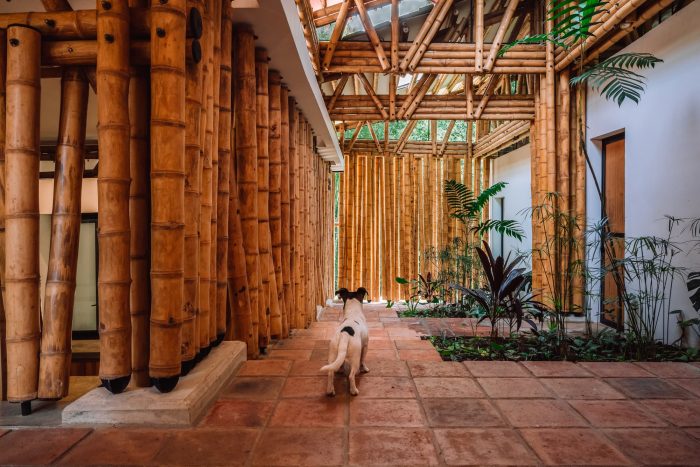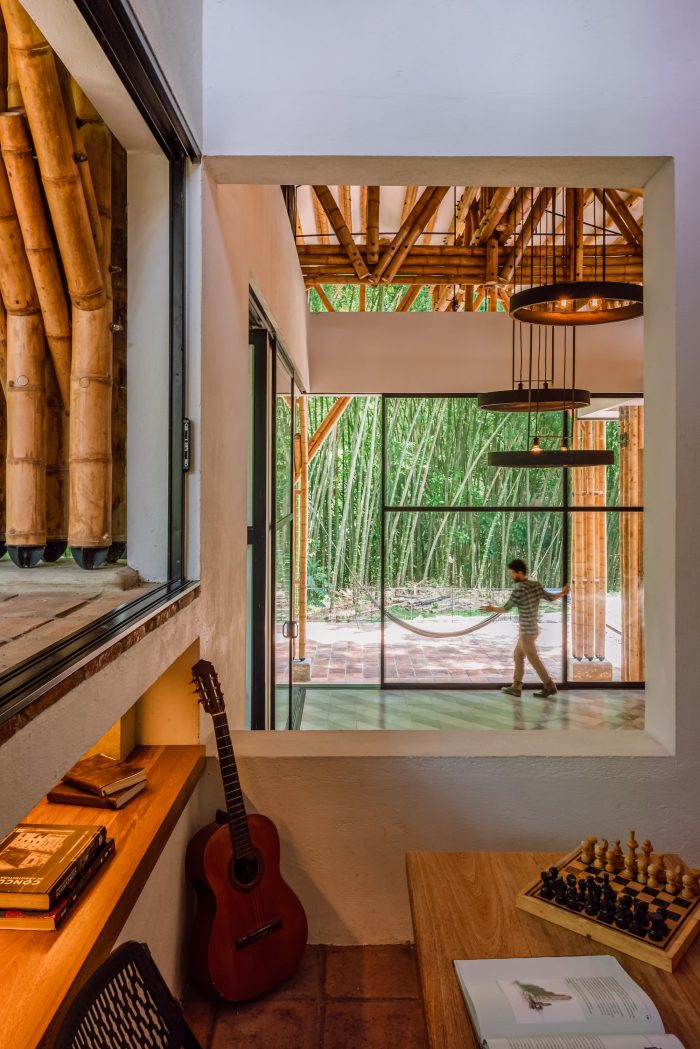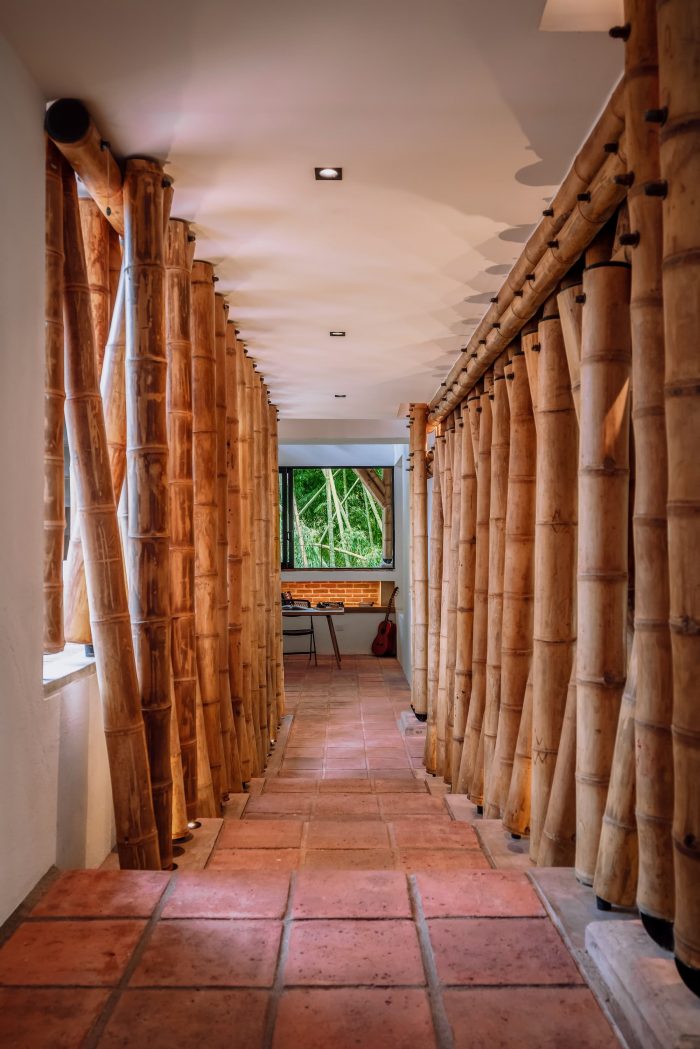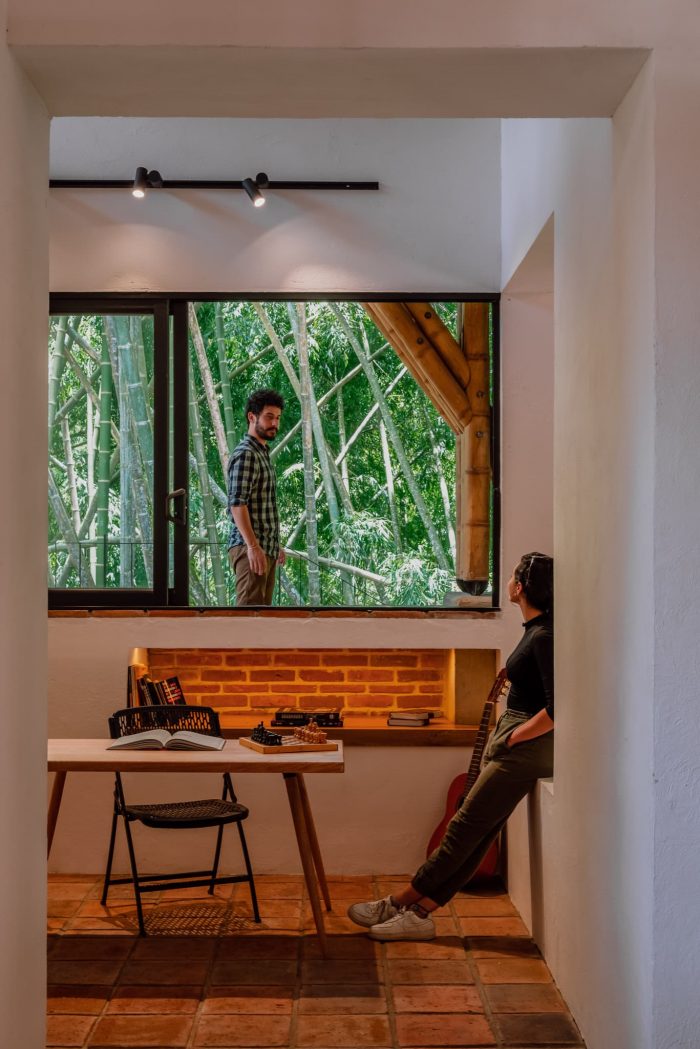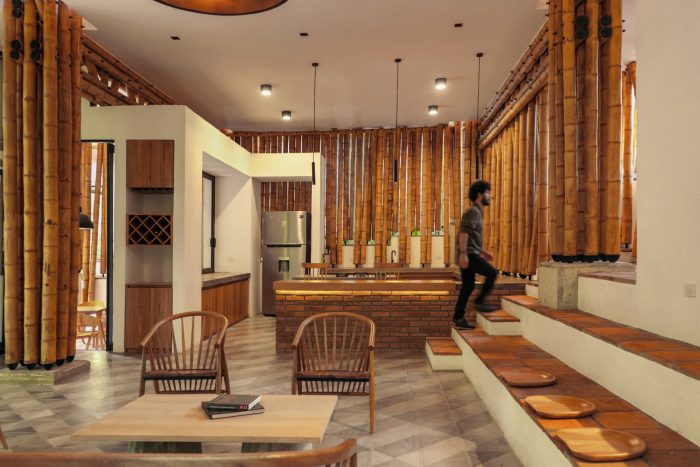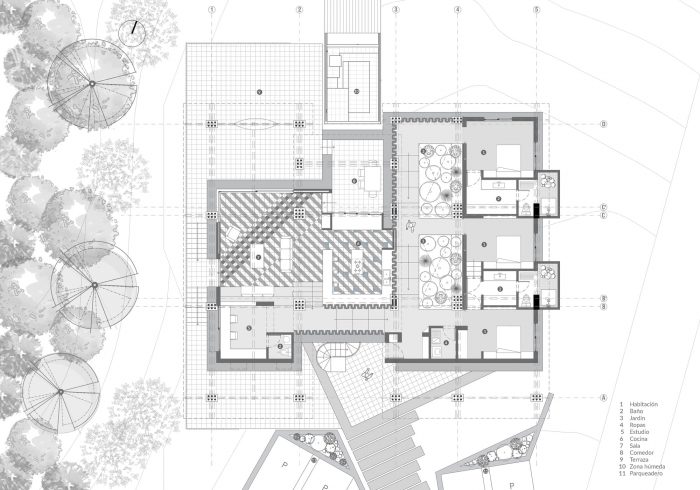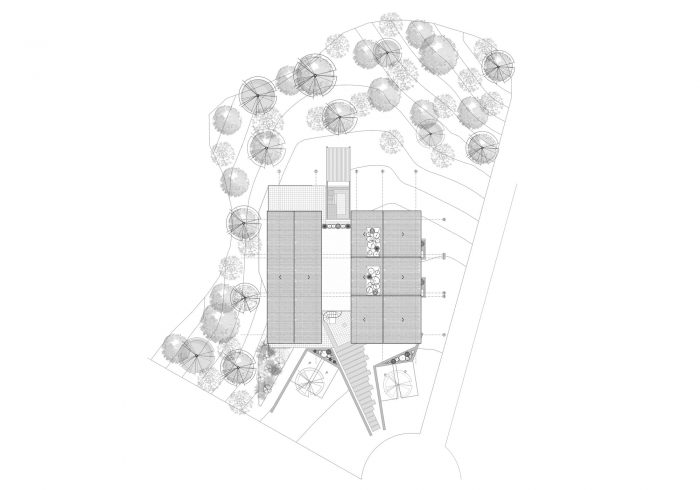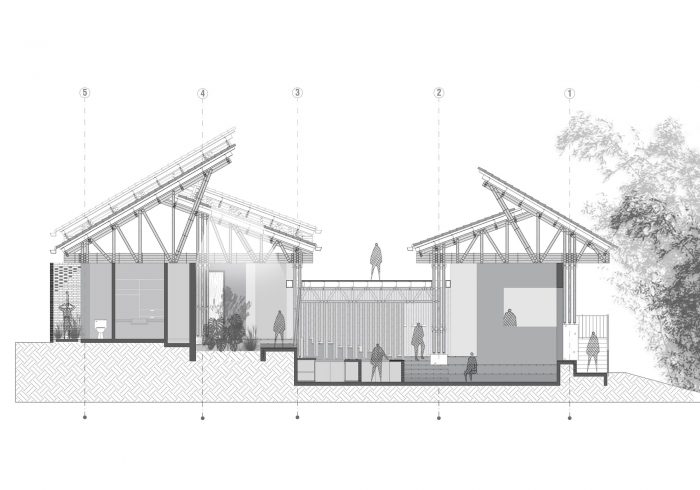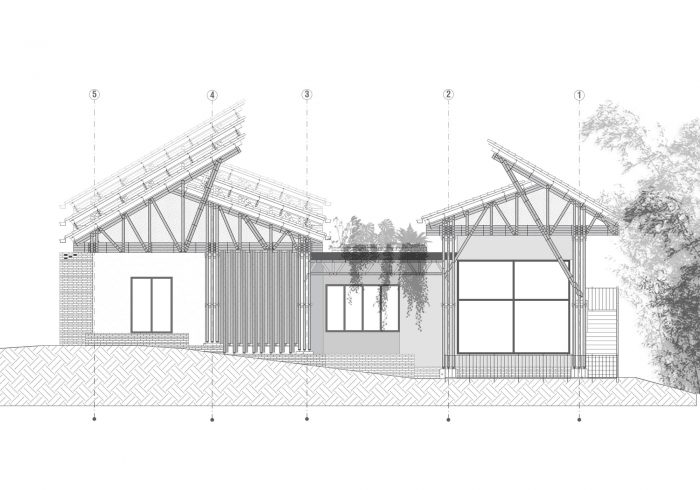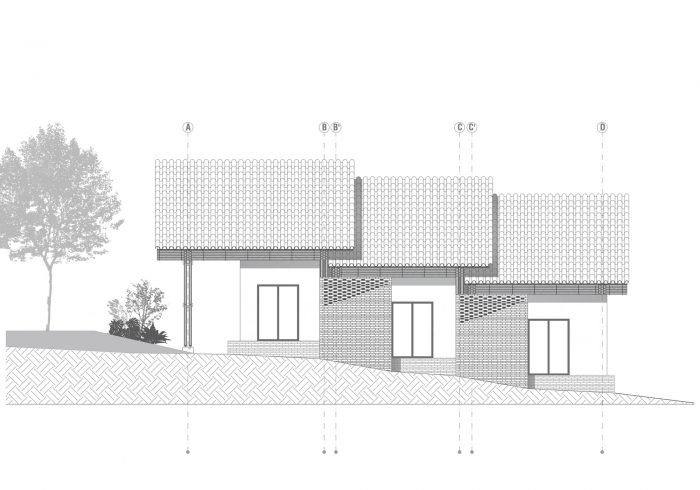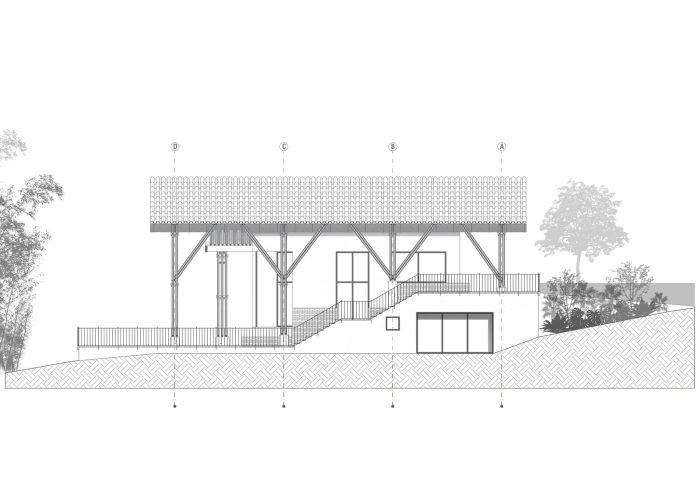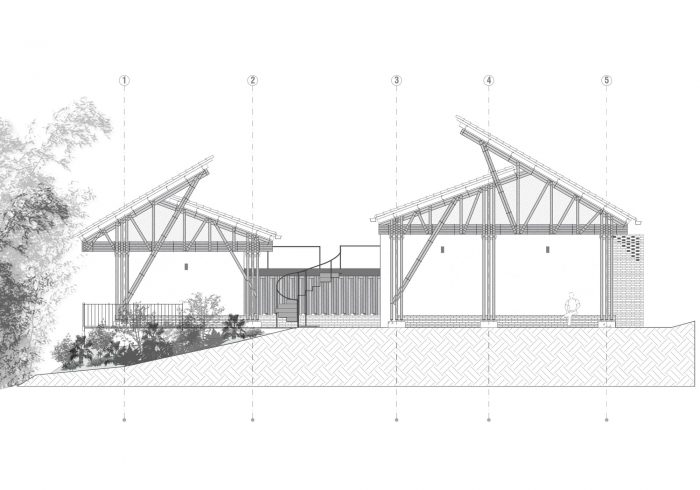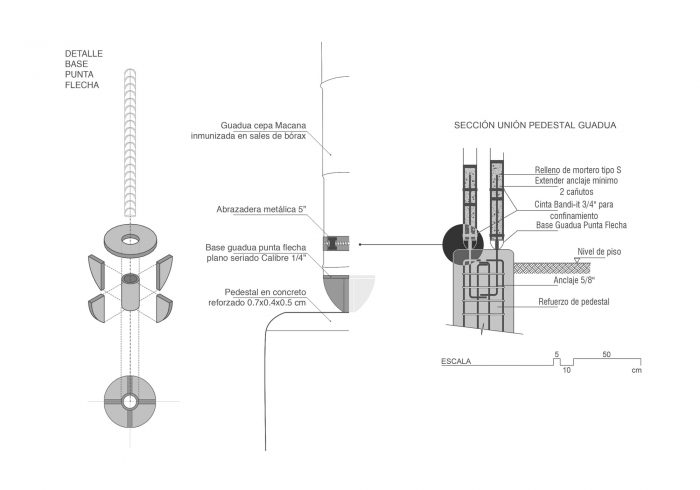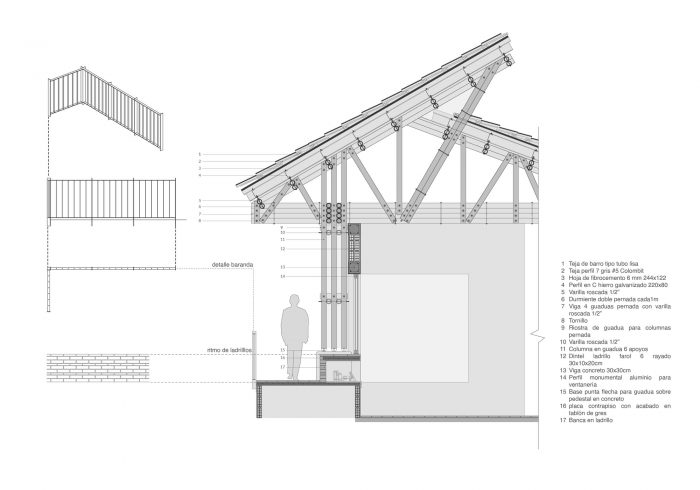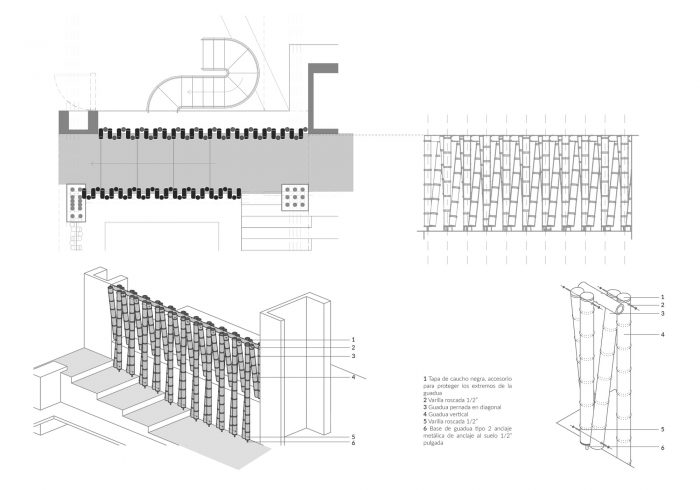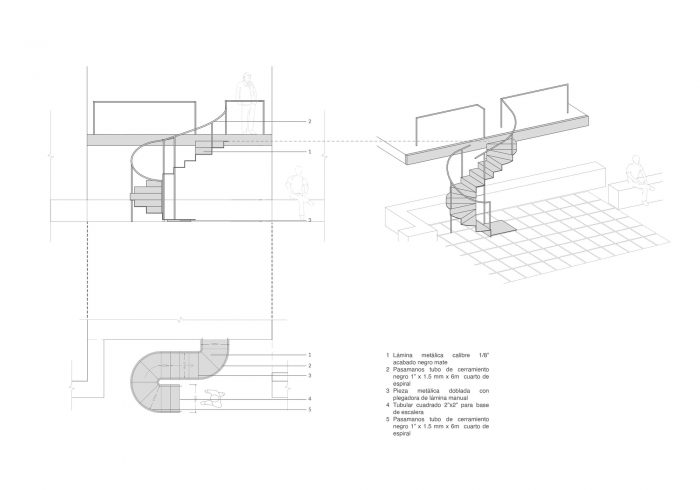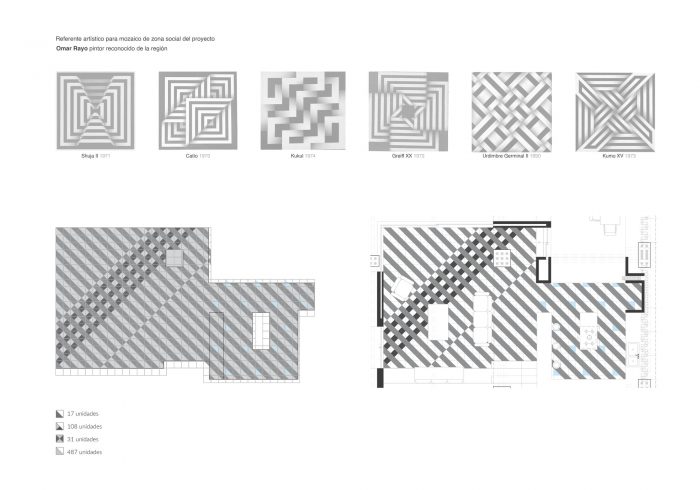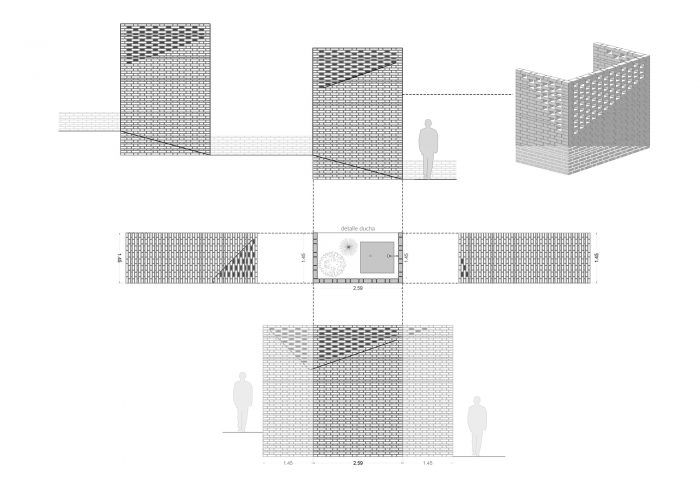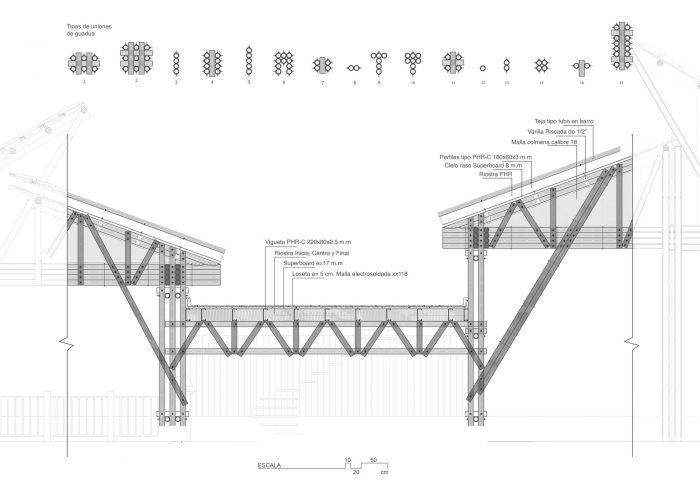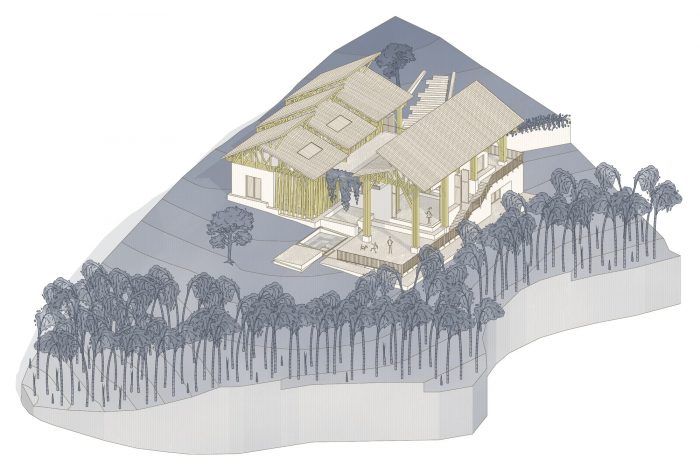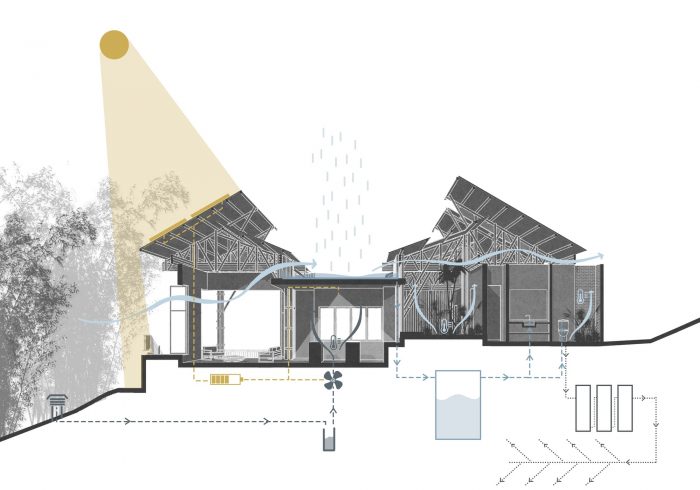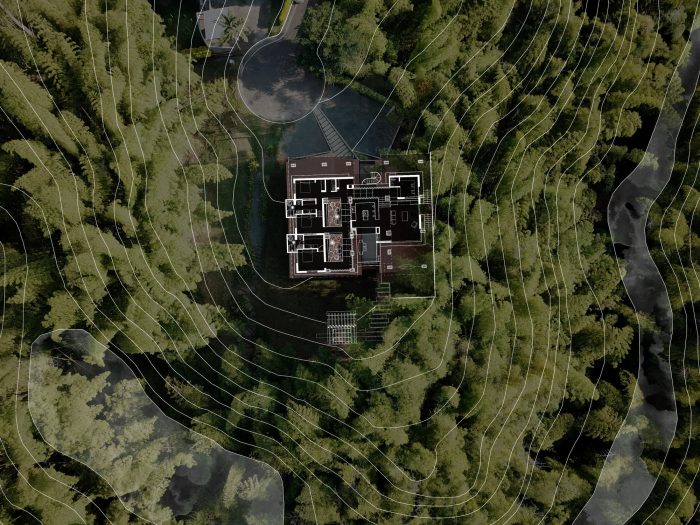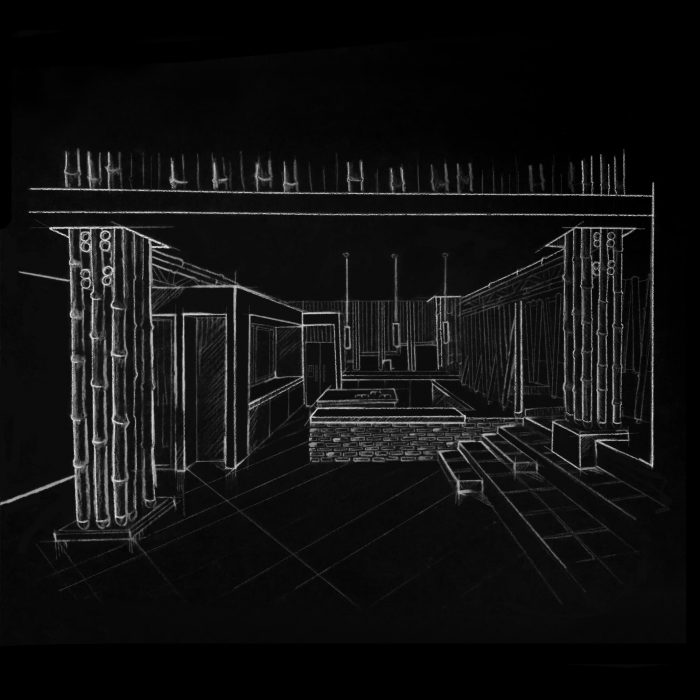Milguaduas被一片原生的瓜杜亚森林所包围,它力求属于它的环境,并与下降的地形完美地结合在一起。这座房子不仅仅是沉浸在大自然中。它建立了一个期望,通过其纯洁的白墙、揭示内部一瞥的Guadua屏风以及掩盖入口的视错觉,呈现出内敛的第一印象。
Surrounded by a native guadua forest, Milguaduas strives to belong to its environment and fit seamlessly in a descending terrain. The house goes beyond being immersed in nature. It builds up expectations by presenting an introverted first impression with its pristine white walls, a guadua screen that reveals glimpses inward, as well as an optical illusion that conceals the entrance.
这座房子从哥伦比亚咖啡种植者文化景观(PCCC)的农村房屋中抽象出具有代表性的特征,以便在当代背景下重新解释传统的原型,从而寻求永恒的效果。一个宽大的基座护卫着白色的墙壁,防止到达地面,从内部挖空,作为家庭办公室的书架区,同时在房子的轮廓上创造出面向森林的座椅。围绕着这个周围的长椅,是一条传统的走廊,由细长的铁扶手环绕着。这个栏杆脱离了传统macanaspindles的本质,几乎透明地站在景观面前。反过来,这些特征又被屋檐两端的屋檐所遮挡,传统的形状和材料。
The house abstracts representative traits from the Colombian Coffee Grower Cultural Landscape (PCCC) rural houses, in order to reinterpret conventional archetypes in a contemporary context, thus seeking timelessness. A broad plinth guards the white walls against reaching the floor, hollowed from the inside to double as the home office’s shelf area, all while creating seats in the outline of the house facing the forest. Around this surrounding bench lies a traditional corridor encircled by a slender iron handrail. This railing detaches the essence of the traditional macanaspindles, standing almost transparently before the landscape. In turn, these features are sheltered by eaves at the ends of the gable roof, traditional in shape and material.
该项目整合了匈牙利建筑师马塞尔-布劳尔制定的为不同活动分配区域的原则。因此,房子被分为两个核心:一个休闲翼和一个聚会翼。在其正式的结构中,休闲区由一个被隔成三个单元的屋檐围住。相比之下,聚会区被一个连续的屋檐和一个受现代主义运动启发的可居住的屋顶所遮挡。因此,休闲和聚会空间通过Guadua屏幕不规则地相互影响。这种窗帘式的分割塑造了立面,同时向内折叠,将垂直的guadua带入家中,并为社交区创造了一个庄严的下降式入口,从而加强了两个核心之间的模糊联系。
The project integrates the principle of assigning areas for different activities, formulated by Hungarian architect Marcel Breuer. As a result, the house is divided into two cores: a leisure wing and a gathering wing. In its formal structure, the leisure area is enclosed by a gable roof partitioned into three units. By contrast, the gathering area is sheltered under both a continuous gable roof and a habitable rooftop inspired by the modernist movement. Thereby, leisure and gathering spaces interact irregularly with each other through the guadua screen. This curtain-like segmentation shapes the façade, while folding inwards to bring the vertical guadua into the home and creating a stately descending entryway to the social area, thus reinforcing the blurred connection between both cores.
这座房子优先考虑它的聚会区,作为一个广泛的空间,在不同层次上产生互动,同时保持房间之间的层次,充满了单一性和比例。一个Guadua隧道作为其末端的森林的框架,通过揭示楼下发生的事情来建立期望。客厅的通道从狭窄到开放,观众的注意力被投射在水泥砖上的影子般的条状物所吸引,就像在森林里一样。在同一层面上,厨房位于房子的中心,没有墙壁使它与周围的房间有一个外围关系。餐厅,有屋顶但又是开放式的,作为房屋覆层内部和外部的中间地带发挥作用。在这里,部分被Guaduaportico遮挡,当地的外来野生动物经常光顾这个露台。
The house prioritizes its gathering area as a broad space that generates interaction on different levels while keeping the hierarchy between rooms filled with singularity and proportion. A guadua tunnel acts as framing for the forest at its end and builds expectation by revealing glances of what happens downstairs. The living room access goes from narrowness to openness, where the viewer’s attention is absorbed by the shadowlike strips projected on the cement tiles as if originated in the forest. At the same level, the kitchen is located at the heart of the house, where the absence of walls allows a peripheral relation to its surrounding rooms. The dining room, roofed yet open-ended, works as a middle ground between the inside and outside of the house’s cladding. Here, partially shielded by a guaduaportico, the terrace is frequented by local exotic wildlife.
Milguaduas利用自然资源,在材料和布局上营造一个可持续的环境,从而减少对环境和能源的影响。该设计只选择了五种材料作为它的语言:当地的瓜杜阿竹子、纯净的白墙、浇筑的混凝土、焊接的黑色金属和烘烤的粘土。在它们的纯粹性中,这些材料具有单色和丰富的纹理色调。通过建立屋顶和覆层之间的独立性,以及屋檐和可居住屋顶的错位,室内可以利用自然光和通风。这种错位是通过安排分层下降来体现的,在这里,房间是向下布置的,同时也提供了可以逗留的区域。可居住的屋顶作为雨水收集的渠道,位于传统的粘土屋檐之间,它绘制了一个包围森林的框架。这个板块,以及通往它的雕塑性折叠楼梯,在传统的原型中散发出现代的气息。
Milguaduas draws on natural resources to foster a sustainable environment in materials as well as its layout, thus reducing its environmental and energetic impact. The design selects exclusively five materials as its language: locally sourced guadua bamboo, pristine white walls, poured concrete, welded black metal, and baked clay. In their purity, the materials have a monochrome and texture-rich tone. By establishing independence between roof and cladding, as well as in the gable roof and habitable roofing being dislocated, the interiors avail themselves of natural light and ventilation. This displacement is mirrored by arranging a layered descent adhering to the terrain, where rooms are laid out downwards while enabling areas for lingering. The habitable roofing acts as a canal for rainwater harvesting, lying between the traditional clay gable roof which draws a frame enclosing the forest. This plate, as well as the sculptural folded staircase that leads to it, gives off a breath of modernity among traditional archetypes.
Architects: ritmo arquitectos
Area : 520 m²
Year : 2021
Lead Architect : Juan José Álvarez Sanz
Architect Site Management : Paula Díaz y Juan José Álvarez Sanz
Collaborating Architect : Juliana Muñoz
City : Pereira
Country : Colombia

